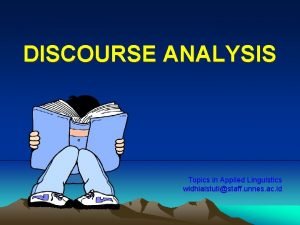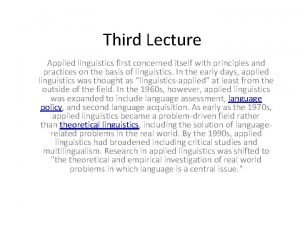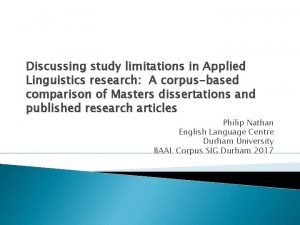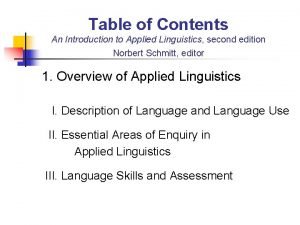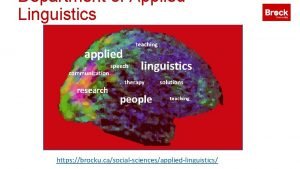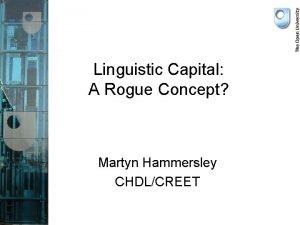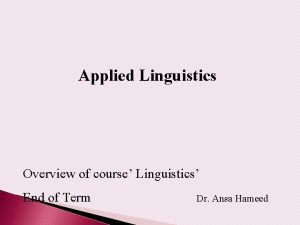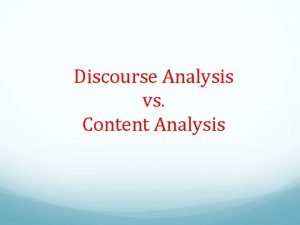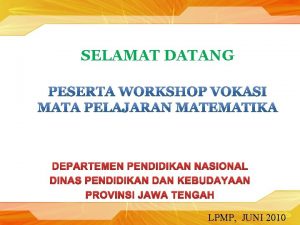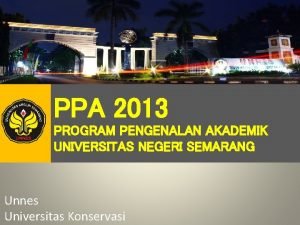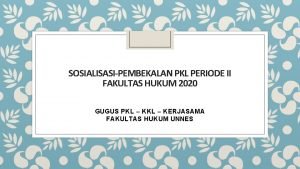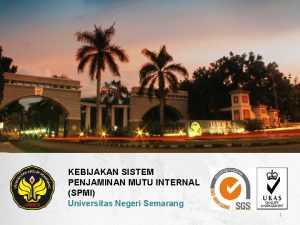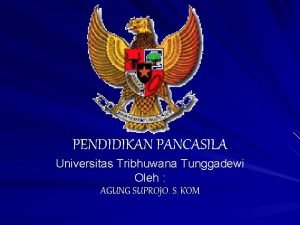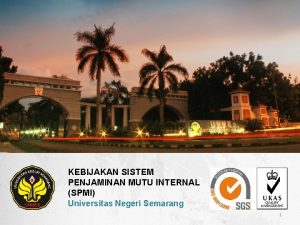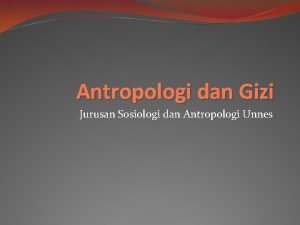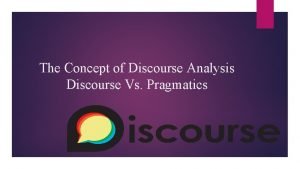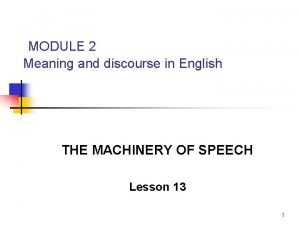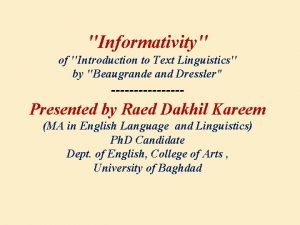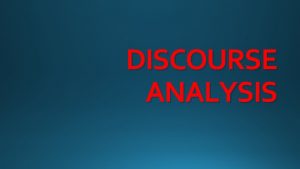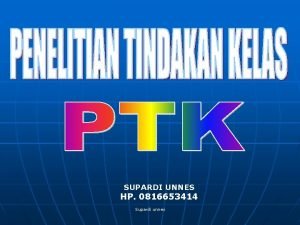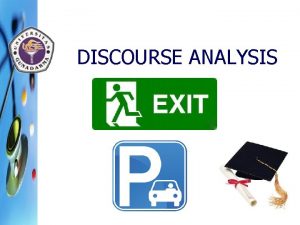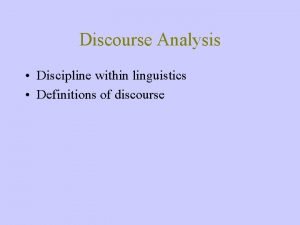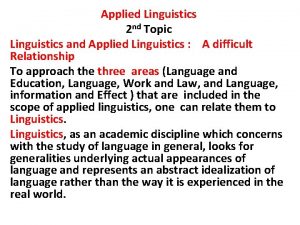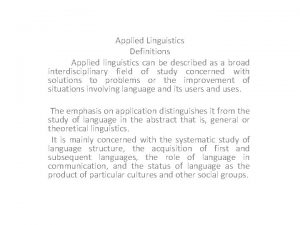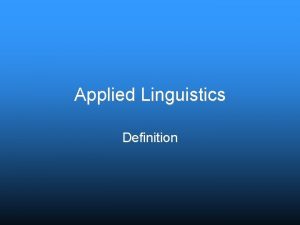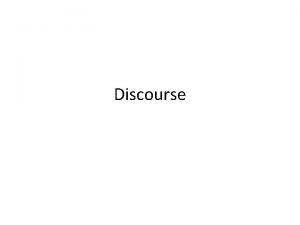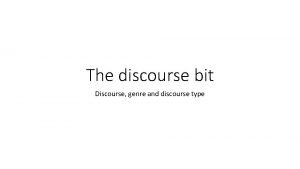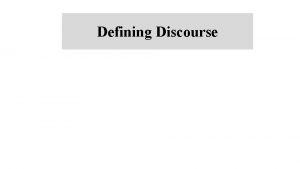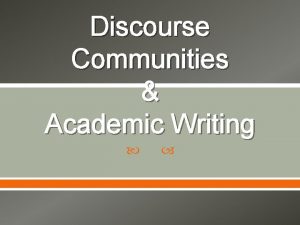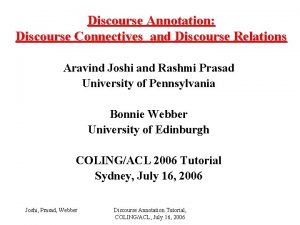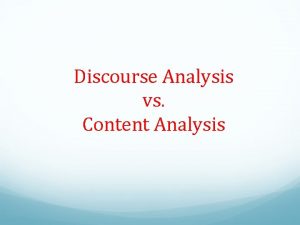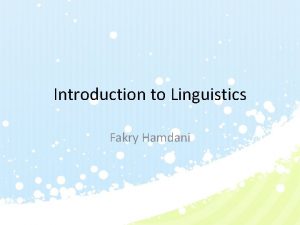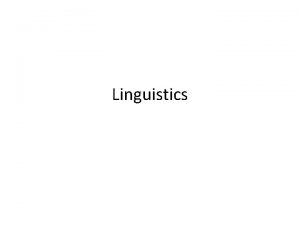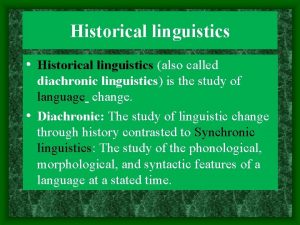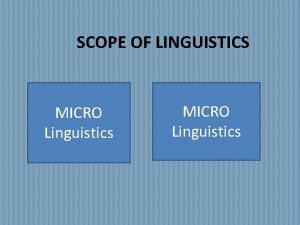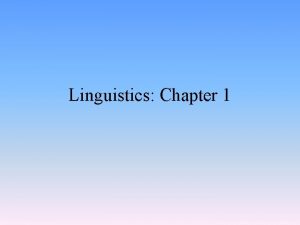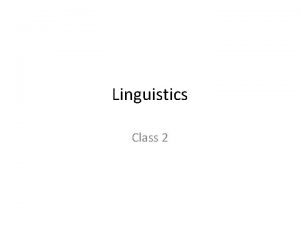DISCOURSE ANALYSIS Topics in Applied Linguistics widhiaistutistaff unnes




























- Slides: 28

DISCOURSE ANALYSIS Topics in Applied Linguistics widhiaistuti@staff. unnes. ac. id

M. Stubbs' textbook (Stubbs 1983: 1), discourse analysis is defined as a) concerned with language use beyond the boundaries of a sentence/utterance, b) concerned with the interrelationships between language and society and c) as concerned with the interactive or dialogic properties of everyday communication.

Text or Discourse Analysis?

Text analysis • Needs linguistic analysis • Interpretation is based on linguistic evidence • Text analysts need the right ‘knife’ to cut the right ‘bread’ • Different ‘knives’ for different ‘bread’

Discourse analysis • How texts relate to contexts of situation and context of culture • How texts are produced as a social practice • What texts tell us about happenings, what people think, believe etc. • How texts represent ideology (power struggle etc. )

Text & Discourse Analyses (Nunan, 1993) • Text analysis is the study of formal linguistic devices that distinguish a text from random sentences. • Discourse analysts study these text-forming devices with reference to the purposes and functions for which the discourse was produced, and the context within which the discourse was created. The ultimate goal is to show the linguistic elements enable language users to communicate.

• The term discourse analysis is very ambiguous. • I will use it in this book to refer mainly to the linguistic analysis of naturally occurring connected speech or written discourse. • Roughly speaking, it refers to attempts to study the organisation of language above the sentence or above the clause, and therefore to study larger linguistic units, such as conversational exchanges or written texts. • It follows that discourse analysis is also concerned with language use in social contexts, and in particular with interaction or dialogue between speakers.

Definition of Discourse Analysis: • The study of how stretches of language used in communication assume meaning, purpose and unity for their users: the quality of COHERENCE • A general consensus: COHERENCE does not derive solely from the linguistic forms and propositional content of a text, though these may contribute to it.

• COHERENCE derives from an interaction of text with given participants (context) • Context: participants’ knowledge and perception of paralanguage, other texts, the situation, the culture, the world in general and the role, intentions and relationships of participants.

Approaches to DA 1. 2. 3. 4. 5. 6. 7. Speech Act Theory Interactional Sociolinguistics Ethnography of Communication Pragmatics Conversational Analysis Variation Analysis SFL

Speech Act Theory (Austin 1955, Searle 1969) – A logico-philosophic perspective on conversational organization focusing on interpretation rather than the production of utterances in discourse. – From the basic belief that language is used to perform actions. – Every utterance can be analyzed as the realization of the speaker’s intent (illocutionary force) to achieve a particular purpose. – Neither Austin nor Searle were concerned with the analysis of continuous discourse.

Speech Act Theory – Unit of analysis: speech act (SA) or illocutionary force (IF). – Principal problems: the lack of a one-to-one match up between discourse function (IF) and the grammatical form. – Provides the insight that the basic unit of conversational analysis must be functionally motivated rather than formally defined one. – Systemic name : speech function (SF) – central issue in discourse structure.

Interactional Sociolinguistics (Gumperz 1982, Goffman 1959 -1981) – Grows out of the work of anthropologists. – Centrally concerned with the importance of context in the production and interpretation of discourse. – Units of analysis: grammatical and prosodic features in interactions. – Gumperz demonstrated that interactants from different socio-cultural backgrounds may “hear” and understand discourse differently according to their interpretation contextualisation cues in discourse. E. g. intonation contours, ‘speaking for another’, alignment, gender.

Interactional Sociolinguistics – Schiffrin (1987): focused on quantitative interactive sociolinguistic analysis, esp. discourse markers (defined as ‘sequentially dependent elements which bracket units of talk). – Schiffrin’s unit of analysis: turn. – Basic concern: the accomplishment of conversational coherence. – She argues for the importance of both qualitative and quantitative / distributional analysis in order to determine the function of the different discourse markers in

Ethnography of Communication (Dell Hymes (1972 b, 1974) – Concerned with understanding the social context of linguistic interactions: ‘who says what to whom, when, where. Why, and how’. – Prime unit of analysis: speech event. – Definition: ‘The speech event is to what analysis of verbal interaction what the sentence is to grammar … It represents an extension in the size of the basic analytical unit from the single utterance to stretches of utterances, as well as a shift in focus from … text to … interaction’.

Ethnography of Communication – Speech event refers to ‘activities … that are directly governed by rules or norms for the use of speech’ (Hymes 1972: 56) – Speech event comprises components (Hymes SPEAKING grid). – Analysis of these components of a speech event is central to what became known as ethnography of communication or ethnography of speaking, with the ethnographer’s aim being to discover rules of appropriateness in speech events. – Genres often coincides with speech events

Ethnography of Communication – The ethnographic framework has led to broader notions of communicative competence. – Problem: Lack of explicitness in Hymes’ account on the relationship between genre and other components of the speaking grid and their expression in language and – Recognition of the close relationship between speech events and their social/cultural contexts.

Pragmatics (Grice 1975, Leech 1983, Levinson 1983) – Formulates conversational behaviour in terms of general “principles” rather than rules. – At the base of pragmatic approach is to conversation analysis is Gricean’s co-operative principle (CP). – This principle seeks to account for not only how participants decide what to DO next in conversation, but also how interlocutors go about interpreting what the previous speaker has just done. – This principle is the broken down into specific maxims: Quantity (say only as much as necessary), Quality (try to make your contribution one that is true), Relation (be relevant), and manner (be brief and avoid ambiguity).

Pragmatics – Provides useful means of characterizing different varieties of conversation, e. g. in interactions, one can deliberately try to be provocative or consensual. – Significant problem: it implies that conversations occur co-operatively, between equals where power is equally distributed etc. – In reality: conversations involve levels of disagreement and resistance; power is constantly under contestation.

Conversation Analysis (CA) (Harold Garfinkel 1960 s-1970 s) – Garfinkel (sociologist) concern: to understand how social members make sense of everyday life. – Sack, Schegloff, Jefferson (1973)tried to explain how conversation can happen at all. – CA is a branch of ethnomethodology. – Two grossly apparent facts: a) only one person speaks at a time, and b) speakers change recurs. Thus conversation is a ‘turn taking’ activity. – Speakers recognize points of potential speekar change – turn constructional unit (TCU).

Conversation Analysis (CA) – CA identified TCU as the critical units of conversation, it has not specified exactly how a TCU boundary can be recognized in any situation. – Models conversation as infinitely generative turn-taking machine, where interactants try to avoid lapse: the possibility that no one is speaking. – Contribution: the identification of ‘adjacency pairs’: conversational relatedness operating between adjacent utterances.

Conversation Analysis (CA) – Adjacency pair: first and second pair parts. – Major problems: a) lack of systematicity- thus quantitative analysis is impossible; 2) limited I its ability to deal comprehensively with complete, sustained interactions; 3) though offers a powerful interpretation of conversation as dynamic interactive achievement, it is unable to say just what kind of achievement it is.

Variation Analysis (Labov 1972 a, Labov and Waletzky 1967) – L & W argue that fundamental narrative structures are evident in spoken narratives of personal experience. – The overall structure of fully formed narrative of personal experience involves six stages: 1) Abstract, 2) Orientation, 3) Complication, 4) Evaluation, 5) Resolution, 6) Coda where 1) and 6) are optional. – Strength: its clarity and applicability.

Variation Analysis – Problems: data was obtained from interviews. – Variationists’ approach to discourse stems from quantitative of linguistic change and variation. – Although typically focused on social and linguistic constraints on semantically equivalent variants, the approach has also been extended to texts.

Functional approach to discourse • Roman Jakobson: language performs six functions: üAddressor(emotive); üContext (referential) üAddressee (conative); üContact (phatic); üMessage (poetic); üCode (metalinguistic).

Functional approach to discourse • Utterances may have multiple functions; • The major concern: discourse analysis can turn out into a more general and broader analysis of language functions. Or it will fail to make a special place for the analysis of relationships between utterances.

Structural-Functional Approaches to Spoken Discourse • Refers to two major approaches to discourse analysis which have relevance to the analysis of casual conversation • They are the Birmingham School and Systemic Functional Linguistics.

Structural-Functional Approaches • Major question: What is conversational structure? • Attempt to relate the description of conversational structure to that of other units, levels, and structures of language. • Draw on semantic theory (Firth 1957) and Palmer (1968) • Seek to offer functional interpretations of discourse structure as the expression and dimensions of the social and cultural context.
 Discourse analysis topics
Discourse analysis topics Applied linguistics history
Applied linguistics history What is discourse and discourse analysis
What is discourse and discourse analysis Discourse analysis definition
Discourse analysis definition Register and signalling vocabulary
Register and signalling vocabulary Traditional linguistics and modern linguistics
Traditional linguistics and modern linguistics Subfields of applied linguistics
Subfields of applied linguistics Characteristics of applied linguistics
Characteristics of applied linguistics Scope of applied linguistics
Scope of applied linguistics Limitations of applied linguistics
Limitations of applied linguistics An introduction to applied linguistics norbert schmitt
An introduction to applied linguistics norbert schmitt Brock university applied linguistics
Brock university applied linguistics Linguistic capital meaning
Linguistic capital meaning Linguistic branch
Linguistic branch Discourse analysis and content analysis
Discourse analysis and content analysis Iwan junaedi unnes
Iwan junaedi unnes Luas unram
Luas unram Lp2 unnes
Lp2 unnes 8 nilai konservasi unnes
8 nilai konservasi unnes Sim pkl unnes
Sim pkl unnes Emisnp
Emisnp Daya tampung gizi unnes
Daya tampung gizi unnes 3 pilar konservasi unnes
3 pilar konservasi unnes Presensi online unnes
Presensi online unnes Hubungan sosiologi dengan ilmu gizi
Hubungan sosiologi dengan ilmu gizi The role of context in interpretation slideshare
The role of context in interpretation slideshare Pragmatics discourse analysis
Pragmatics discourse analysis Module 2 meaning
Module 2 meaning Informativity
Informativity
